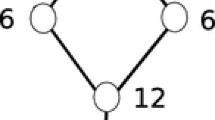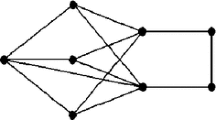Abstract
Graph pebbling, as introduced by Chung, is a two-player game on a graph G. Player one distributes “pebbles” to vertices and designates a root vertex. Player two attempts to move a pebble to the root vertex via a sequence of pebbling moves, in which two pebbles are removed from one vertex in order to place a single pebble on an adjacent vertex. The pebbling number of a simple graph G is the smallest number \(\pi _G\) such that if player one distributes \(\pi _G\) pebbles in any configuration, player two can always win. Computing \(\pi _G\) is provably difficult, and recent methods for bounding \(\pi _G\) have proved computationally intractable, even for moderately sized graphs.
Graham conjectured that the pebbling number of the Cartesian-product of two graphs G and H, denoted \(G\,\square \,H\), is no greater than \(\pi _G \pi _H\). Graham’s conjecture has been verified for specific families of graphs; however, in general, the problem remains open.
This study combines the focus of developing a computationally tractable method for generating good bounds on \(\pi _{G \,\square \, H}\), with the goal of providing evidence for (or disproving) Graham’s conjecture. In particular, we present a novel integer-programming (IP) approach to bounding \(\pi _{G \,\square \, H}\) that results in significantly smaller problem instances compared with existing IP approaches to graph pebbling. Our approach leads to a sizable improvement on the best known bound for \(\pi _{L \,\square \, L}\), where L is the Lemke graph. \(L\,\square \, L\) is among the smallest known potential counterexamples to Graham’s conjecture.
F. Kenter—Partially funded by the Naval Academy Research Council and by NSF Grant DMS-1719894.
D. Skipper—Partially funded by the Naval Academy Research Council.
Access this chapter
Tax calculation will be finalised at checkout
Purchases are for personal use only
Similar content being viewed by others
Notes
- 1.
Our bound carries the caveat that it was obtained by a solver that employs floating point arithmetic.
References
Asplund, J., Hurlbert, G., Kenter, F.: Pebbling on graph products and other binary graph constructions. Australas. J. Comb. 71(2), 246–260 (2017)
Chung, F.: Pebbling in hypercubes. SIAM J. Discrete Math. 2(4), 467–472 (1989)
Cook, W., Koch, T., Steffy, D.E., Wolter, K.: An exact rational mixed-integer programming solver. In: Günlük, O., Woeginger, G.J. (eds.) IPCO 2011. LNCS, vol. 6655, pp. 104–116. Springer, Heidelberg (2011). https://doi.org/10.1007/978-3-642-20807-2_9
Cranston, D.W., Postle, L., Xue, C., Yerger, C.: Modified linear programming and class 0 bounds for graph pebbling. J. Comb. Optim. 34(1), 114–132 (2017). https://doi.org/10.1007/s10878-016-0060-6
Cusack, C.A., Green, A., Bekmetjev, A., Powers, M.: Graph pebbling algorithms and Lemke graphs. Submitted
Elledge, S., Hurlbert, G.H.: An application of graph pebbling to zero-sum sequences in Abelian groups. Integers 5, A17 (2005)
Feng, R., Kim, J.Y.: Pebbling numbers of some graphs. Sci. China Ser. A Math. 45(4), 470–478 (2002). https://doi.org/10.1007/BF02872335
Gurobi Optimization Inc.: http://www.gurobi.com
Herscovici, D.S.: Graham’s pebbling conjecture on products of cycles. J. Graph Theory 42(2), 141–154 (2003). https://doi.org/10.1002/jgt.10080
Herscovici, D.S., Higgins, A.W.: The pebbling number of \({C_5} \times {C_5}\). Discrete Math. 187(1), 123–135 (1998). https://doi.org/10.1016/S0012-365X(97)00229-X
Hurlbert, G.: A linear optimization technique for graph pebbling. arXiv e-prints, January 2011
Hurlbert, G.: Graph pebbling. In: Gross, J.L., Yellen, J., Zhang, P. (eds.) Handbook of Graph Theory, pp. 1428–1449. Chapman and Hall/CRC, Kalamazoo (2013)
Lemke, P., Kleitman, D.: An addition theorem on the integers modulo n. J. Number Theory 31(3), 335–345 (1989). https://doi.org/10.1016/0022-314X(89)90077-2
Milans, K., Clark, B.: The complexity of graph pebbling. SIAM J. Discrete Math. 20(3), 769–798 (2006). https://doi.org/10.1137/050636218
Snevily, H.S., Foster, J.A.: The 2-pebbling property and a conjecture of Graham’s. Graphs Comb. 16(2), 231–244 (2000). https://doi.org/10.1137/050636218
Wang, S.: Pebbling and Graham’s conjecture. Discrete Math. 226(1), 431–438 (2001). https://doi.org/10.1016/S0012-365X(00)00177-1
Wang, Z., Zou, Y., Liu, H., Wang, Z.: Graham’s pebbling conjecture on product of thorn graphs of complete graphs. Discrete Math. 309(10), 3431–3435 (2009). https://doi.org/10.1016/j.disc.2008.09.045
Author information
Authors and Affiliations
Corresponding author
Editor information
Editors and Affiliations
Rights and permissions
Copyright information
© 2018 Springer Nature Switzerland AG
About this paper
Cite this paper
Kenter, F., Skipper, D. (2018). Integer-Programming Bounds on Pebbling Numbers of Cartesian-Product Graphs. In: Kim, D., Uma, R., Zelikovsky, A. (eds) Combinatorial Optimization and Applications. COCOA 2018. Lecture Notes in Computer Science(), vol 11346. Springer, Cham. https://doi.org/10.1007/978-3-030-04651-4_46
Download citation
DOI: https://doi.org/10.1007/978-3-030-04651-4_46
Published:
Publisher Name: Springer, Cham
Print ISBN: 978-3-030-04650-7
Online ISBN: 978-3-030-04651-4
eBook Packages: Computer ScienceComputer Science (R0)




